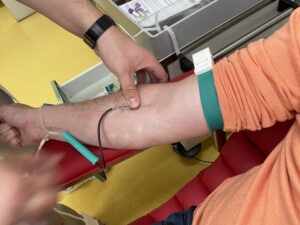Scientists transfused blood from old mice into young ones in a bid to better understand how to mitigate the effects of aging. One of the hallmarks of aging includes senescence, a state in which cells stop growing and dividing.
A new study shows that receiving a single blood transfusion from old mice caused the aging of tissue in young mice. Treatment of older mice with senolytic agents, which are drugs that eliminate senescent cells, before blood transfusions to young mice reduced the levels of senescence markers in young mice.
The study shows that senescence can occur not only due to wear and tear associated with aging but also blood-borne factors.

A recent paper published in Nature Metabolism shows that a single blood transfusion from old mice to young animals can induce senescence— cellular aging — in young mice. The identification of factors in the blood of aged animals that induce aging could help develop therapeutics that slow down aging Study author Dr. Irina Conboy, a professor at the University of California Berkeley, told Medical News Today: “[Our study shows that] cellular senescence is neither cell intrinsic nor a purely chronological — damage accumulation phenomenon; it can be quickly induced in 2 weeks in young animals. Senolytics only partially reduce the negative effects of old blood on young cells and tissues, suggesting additional therapeutic avenues.” Dr. Conboy added that this study further substantiates the role of factors in old blood in promoting aging.
Causes of cellular aging
Cells tend to respond to injury or stress by either undergoing cell death or entering a state where they stop multiplying. This state in which cells stop growing and dividing is known as cellular senescence.
In addition to external stimuli such as stress, intrinsic factors such as changes in DNA structure with aging can also cause senescence.
Upon undergoing senescence, cells can send signals to the immune system, facilitating their removal by immune cells. A gradual decline in the ability of the immune system to remove these senescent cells occurs with aging, resulting in the accumulation of senescent cells. The accumulation of senescent cells contributes to the aging of organs and is associated with chronic diseases.
Senescent cells can also secrete molecules that signal neighboring cells to also undergo senescence. These molecules secreted by senescent cells, known as the senescence-associated-secretory phenotype (SASP), include pro-inflammatory proteins and other factors that remodel the neighboring tissue.
However, the influence of these factors secreted by senescent cells in promoting aging is not well understood. Evidence from previous studies suggests that molecules or cells present in older animals can induce tissue in younger animals to undergo aging.
For instance, studies have shown that surgically joining a young mouse with an older one can rejuvenate the tissue in the older mouse. At the same time, this procedure results in the aging of the tissue in the younger animal. Besides having a common circulatory system, the surgically joined animals also share organs and are exposed to a similar environment. This makes it hard to single out the potential source of the pro-aging or rejuvenating factors.
Likewise, blood transfusion from aged mice to younger mice can cause tissue in the younger animal to age. These studies suggest that certain factors present in the blood of older mice can induce aging in their younger counterparts. However, whether these pro-aging effects of old blood are due to senescent cells is not known.
In the present study, the researchers examined whether senescence could be transferred from older mice to younger ones through blood transfusions.
Blood transfusions and senescence
To assess the ability of old blood to induce senescence, the authors transfused blood from aged mice (22-24 months) to their younger counterparts (3 months). The control group consisted of young rats (3 months) receiving blood transfusions from other young rats of the same age. At 14 days after receiving the blood transfusion, the young mice receiving blood from the older mice showed increased expression of senescence biomarkers in the muscle, kidney, and liver. However, such an increase in the levels of senescence markers was absent in the lungs, heart, and brain.
The young mice that received blood transfusions from older mice also showed deficits in tasks assessing muscle strength and exhibited lower physical endurance.
Similar to skeletal muscle tissue, young mice receiving blood from older mice also showed elevated levels of biomarkers for tissue damage and impaired or suboptimal function in the liver and the kidney.
The researchers also transfused blood from younger mice to older mice and found that receiving young blood decreased tissue damage in the liver, kidney, and muscles of old mice. In sum, these results suggest induction of senescence in young mice after receiving blood transfusions from older mice. Moreover, senescence induced in young animals after receiving blood from old mice was tissue-specific.
The effects of senolytics
The researchers then investigated whether the elimination of senescent cells in aged mice could prevent the induction of senescence in young mice after blood exchange.
For this experiment, the researchers maintained the older mice on a regimen of senolytic drugs that eliminate senescent cells for around 4-6 weeks. As expected, treatment with the senolytic drugs reduced the levels of secreted factors associated with senescence in the plasma of the old mice. The researchers then transfused blood from older mice treated with either senolytic drugs or a vehicle to young mice. Young mice receiving blood from older mice treated with senolytics showed reduced expression of senescence markers in the muscle, liver, and kidneys than young mice receiving vehicle-treated old blood.
Treatment with senolytics also attenuated the decline in liver, muscle, and kidney function and reduced the damage to these organs in young mice receiving old blood. Moreover, administration of senolytics to older mice also reduced the adverse effects of old blood on physical activity levels and energy balance in young mice.
Young mice receiving blood from older mice treated with senolytic drugs also showed lower levels of proteins associated with inflammation, a hallmark of senescence. However, young mice receiving blood from senolytic-treated old mice did show some negative effects associated with the transfusion of old blood. For instance, the administration of senolytics to old mice before the blood transfer failed to prevent some of the negative effects on kidney function in young mice.
These experiments show that the clearance of senescent cells in older mice attenuated the pro-aging effects of the transfer of old blood to young mice. In other words, besides being caused by stress or aging, senescence can also occur due to exposure to factors present in old blood. Further research is necessary to identify the factors — such as molecules, organelles, or senescent cells themselves — present in the blood that were responsible for the induction of senescence in young mice.
Senescent cells secrete a number of signaling molecules in the circulation and these molecules might, at least in part, be responsible for the induction of senescence. The identification of these factors could help develop therapeutics to retard the aging process.
Study implications
Dr. James Kirkland at the Mayo Clinic Kogod Center on Aging said, “[This is an] interesting study that supports the effectiveness of senolytics in alleviating age-related dysfunction. It confirms and extends previous findings that transplanting senescent cells from old into young animals causes dysfunction and that removing those senescent cells from the transplanted mice restores function as well as the finding that transplanting hearts from old into young mice causes the spread of senescence and dysfunction in the young mice while transplanting hearts from young into young mice does not.”
The results of this study raise several interesting questions about aging and potential treatments for slowing down the aging process.
Dr. Stefan Tulius, director of the Transplant Surgery Research Laboratory at Brigham and Women’s Hospital noted that “ any great scientific contribution, this study raises many open questions in addition to providing us with a most relevant aspect on an improved understanding of aging and the potential of increasing health life-span.”
“Those open questions relate particularly to the clinical relevance of the predominantly experimental findings: How much blood will need to be transferred to observe effects? Will a single human blood transfusion make a difference, or will the blood exchange need to go significantly beyond that? For how long will the effects last? Will they be reversible and ‘only’ temporary?”
“The authors report on changes that included long-lasting end-organ damage with scarring in livers and kidneys,” Dr. Tulius added.
“Understanding the mechanisms involved in this process may be most interesting and revealing. Interestingly also, functional effects including compromised physical activities have been observed in mice. Will those be long-lasting or just temporary? Moreover, if physical capacities are compromised, can we then also expect cognitive compromises? Indeed, the authors present fascinating findings raising many intriguing open questions that may guide us to understand aging better and to develop novel approaches facilitating healthy aging,” he went on to note.





































